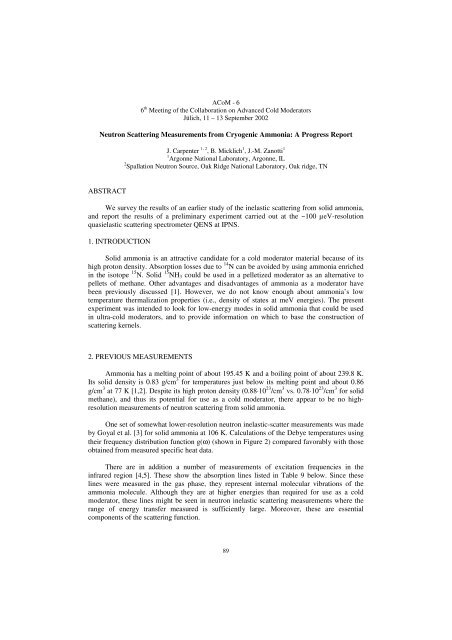Druck-Materie 20b.qxd - JUWEL - Forschungszentrum Jülich
Druck-Materie 20b.qxd - JUWEL - Forschungszentrum Jülich
Druck-Materie 20b.qxd - JUWEL - Forschungszentrum Jülich
Create successful ePaper yourself
Turn your PDF publications into a flip-book with our unique Google optimized e-Paper software.
ACoM - 6<br />
6 th Meeting of the Collaboration on Advanced Cold Moderators<br />
<strong>Jülich</strong>, 11 – 13 September 2002<br />
Neutron Scattering Measurements from Cryogenic Ammonia: A Progress Report<br />
ABSTRACT<br />
J. Carpenter 1, 2 , B. Micklich 1 , J.-M. Zanotti 1<br />
1 Argonne National Laboratory, Argonne, IL<br />
2 Spallation Neutron Source, Oak Ridge National Laboratory, Oak ridge, TN<br />
We survey the results of an earlier study of the inelastic scattering from solid ammonia,<br />
and report the results of a preliminary experiment carried out at the ~100 µeV-resolution<br />
quasielastic scattering spectrometer QENS at IPNS.<br />
1. INTRODUCTION<br />
Solid ammonia is an attractive candidate for a cold moderator material because of its<br />
high proton density. Absorption losses due to 14 N can be avoided by using ammonia enriched<br />
in the isotope 15 N. Solid 15 NH3 could be used in a pelletized moderator as an alternative to<br />
pellets of methane. Other advantages and disadvantages of ammonia as a moderator have<br />
been previously discussed [1]. However, we do not know enough about ammonia’s low<br />
temperature thermalization properties (i.e., density of states at meV energies). The present<br />
experiment was intended to look for low-energy modes in solid ammonia that could be used<br />
in ultra-cold moderators, and to provide information on which to base the construction of<br />
scattering kernels.<br />
2. PREVIOUS MEASUREMENTS<br />
Ammonia has a melting point of about 195.45 K and a boiling point of about 239.8 K.<br />
Its solid density is 0.83 g/cm 3 for temperatures just below its melting point and about 0.86<br />
g/cm 3 at 77 K [1,2]. Despite its high proton density (0.88⋅10 23 /cm 3 vs. 0.78⋅10 23 /cm 3 for solid<br />
methane), and thus its potential for use as a cold moderator, there appear to be no highresolution<br />
measurements of neutron scattering from solid ammonia.<br />
One set of somewhat lower-resolution neutron inelastic-scatter measurements was made<br />
by Goyal et al. [3] for solid ammonia at 106 K. Calculations of the Debye temperatures using<br />
their frequency distribution function g(ω) (shown in Figure 2) compared favorably with those<br />
obtained from measured specific heat data.<br />
There are in addition a number of measurements of excitation frequencies in the<br />
infrared region [4,5]. These show the absorption lines listed in Table 9 below. Since these<br />
lines were measured in the gas phase, they represent internal molecular vibrations of the<br />
ammonia molecule. Although they are at higher energies than required for use as a cold<br />
moderator, these lines might be seen in neutron inelastic scattering measurements where the<br />
range of energy transfer measured is sufficiently large. Moreover, these are essential<br />
components of the scattering function.<br />
89

















